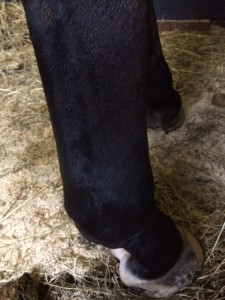During the winter months it is not uncommon for an owner to go to the stable and encounter their horse with lower legs looking like tree trunks!
Swelling of lower limbs is prevalent in stabled horses, and can be down to a number of causes: If there is swelling in just one leg it may be down to a serious problem such as infection due to trauma/injury, or Ulcerative Lymphangitis. If this is the case, you may need to consult your vet. This swelling is less likely to decrease with movement, and may be accompanied by one or all of the following symptoms; high temperatures, loss of appetite, sweating, obvious pain, colic type problems.
However, if the swelling does not seem to be painful or overly warm, is diffuse throughout the lower leg, and more than one limb is affected, it is likely to be a less serious problem, often referred to as Sporadic Lymphangitis. The horse may be stiff, but is not truly lame. This normally occurs after periods of inactivity, e.g. after being stabled overnight, and is more common in older horses. With this type of Lymphangitis, swelling is usually diffuse and may affect different limbs to different extents, and usually subsides with turnout or riding.
To reduce the likelihood of your horse getting filled legs:
- Try to keep standing in to a minimum - turn out as much as possible, using a school or concrete pad if fields are not available.
- If your horse must be stabled for long periods, try to keep them moving by exercising - if they can’t be ridden walking in hand or using a horse walker is ideal to promote fluid dispersion.
- Bandaging the legs will help to reduce swelling.
- Certain herbs can also help to stimulate the lymphatic and circulatory systems.
For more advice please call 0800 585525 or use the live chat service to speak to one of our friendly Nutritionists.
Olivia Colton MSc
Nutritional and Technical Coordinator












